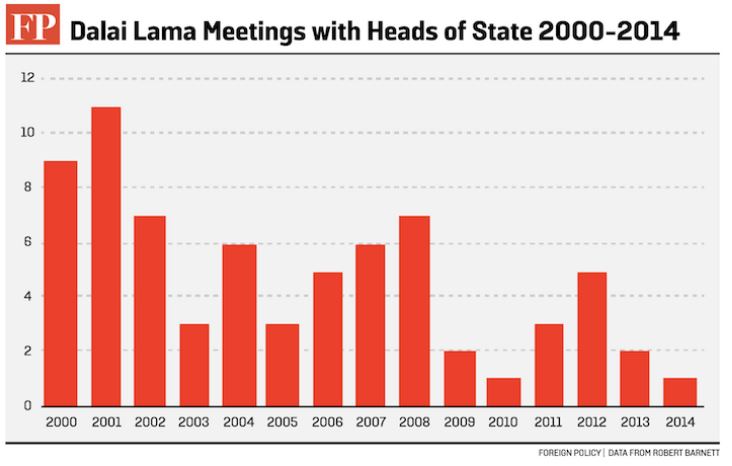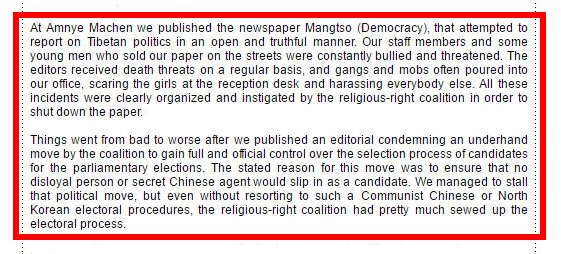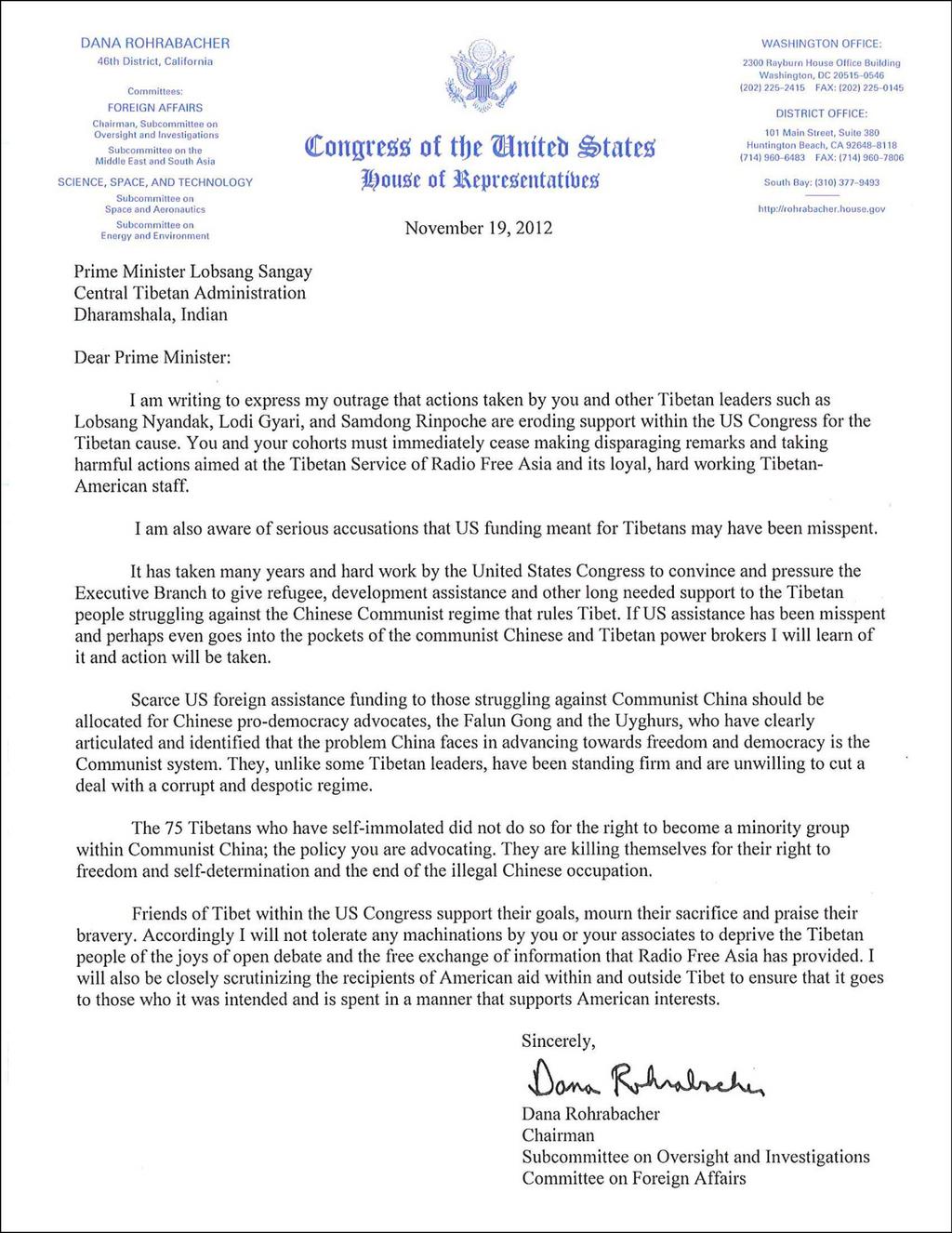It was recently brought to my attention that there are many parallels between human rights abuses committed by the Tibetan leadership, and abuses committed by other governments in the world. In particular, my contact wished to highlight a documentary on the lucrative relationship between Western nations such as the United States and United Kingdom, and the Kingdom of Saudi Arabia. Upon viewing the footage, it quickly became clear that there is indeed very little difference between Saudi Arabia, an absolute monarchy labelled autocratic by some, and the exiled Tibetan leadership which is headquartered in Dharamsala, North India.
The motivation behind this post is not criticize Saudi Arabia or examine the Saudi kingdom’s activities and interests. Instead, it is to examine the information presented in the documentary, and compare it against what is widely known about the Tibetan leadership’s abusive activities against their own people. It is also to highlight to readers how such abuses will be readily ignored by countries who claim to be democracies, because there is some kind of economic incentive for them to do so. While these nations may expound democratic principles, and promote freedom of speech and freedom of worship as universal human rights, over time it becomes increasingly clear that these values are only upheld when it is convenient and financially beneficial for them to do so. As a result, we will see that the are many parallels between the relationship that the West has with Saudi Arabia, and the relationship that they have with the exiled Tibetan leadership.
Inside Saudi Arabia: Butchery, Slavery & History of Revolt
Parallel #1: Both societies are ruled by one absolute leader
In the Kingdom of Saudi Arabia, the same family (the House of Saud) have ruled the country since its founding in 1932. Within the Tibetan community, the Dalai Lamas have ruled Tibet as an absolute ruler since 1642 after the Mongols established this institution as the indisputable rulers of the Tibetan people.
In both instances, there is no opportunity for anyone to consider that they could possibly become the rulers of the country. Unlike in a true democracy where a child can dream of becoming the next President or Prime Minister, succession of true power in Saudi Arabia is hereditary through the House of Saud. Meanwhile, among the Tibetans, no one can ever become the ruler of the Tibetan people unless they are the next Dalai Lama.
Parallel #2: Elected officials are mere figureheads with no real power
According to the documentary, publicly elected officials in Saudi Arabia have little real power and can be overruled by the King at any time. Within the Tibetan community, it is the exact same situation. There exists an unquestioned faith and unwavering reliance on His Holiness the Dalai Lama. This means that any publicly elected official such as the Sikyong Dr Lobsang Sangay can easily be overruled by anything the Dalai Lama says, whether directly or in passing. Laws can be rolled back, policies changed and people targeted on the basis of “the Dalai Lama said so”. Thus, practically speaking, in both Saudi Arabia and in the Tibetan community, publicly elected officials can easily be overridden and overruled by the absolute ruler.

Over the years, fewer heads of state have been willing to meet with the Tibetan leadership. Despite His Holiness the Dalai Lama’s ongoing popularity with the media, perhaps they have realized that there is little to gain in meeting with him, and it would be more prudent for them to befriend China instead of antagonise them.
Parallel #3: Public dissension is not tolerated
In Saudi society, any forms of dissension are not tolerated and protesting against the government is illegal. In fact, any sign of dissent is immediately quashed, and brutally and violently suppressed. The Tibetan equivalent of this is a leadership that directs physical harm towards their political and philosophical opponents. Those perceived as being against the leadership and their diktats have been threatened, poisoned, stabbed, beaten, been killed in suspicious car ‘accidents’, and had their houses stoned and properties seized. They have even had riots organized against them if they dare to speak out, let alone act, against the leadership.
Parallel #4: Alternative views are treasonous
The Saudi leadership is known for their intolerance of alternative views, and draconian censorship laws are in place to ensure that only the government’s views and policies are publicized. Anything that does not tow the leadership’s version of events is viewed as treason and sedition. The same can be said of the exiled Tibetan leadership, where there is near-universal intolerance for any views that do not match His Holiness the Dalai Lama’s.
If anyone should have the temerity to express views that differ from the Dalai Lama’s, they are immediately labelled as ‘anti-Dalai Lama’ and as committing treason against the Tibetan leadership. This means even if they are teenagers simply asking questions, they are fair game for any consequence that befalls them, physical and violent or otherwise. This type of intolerance towards views that do not match the Dalai Lama’s is prevalent in Tibetan society, and it is encouraged and bolstered by the Tibetan leadership. They either remain silent whenever such intolerance is expressed, or they fund websites and publish books and documentaries demonstrating intolerance against their own people’s choice of faith.
Parallel #5: Everyone will know if you protested
Those who protest against the Saudi leadership will find their names published on a list so that, according to the documentary, they can be hunted down and / or arrested. Similarly, within Tibetan society, it is well known that Dorje Shugden protestors who refuse to comply with the leadership’s diktats on giving up the practice, will be targeted for harassment. Those who have the courage to protest against the Tibetan leadership are advertised as anti-Dalai Lama. Thereafter hit lists with their photos, names and personal details such as their addresses are widely circulated throughout the Tibetan settlements, and published on the Tibetan leadership’s website.
To objective observers of the situation, it is clear that there is no reason to circulate such lists other than to ensure that violence is directed against the protesters who, hopefully with the threat of violence, will be intimidated into silence. No true democracy in the world would ever dream of behaving in such a manner. Imagine the uproar there would be if the President of the United States, or the Prime Minister of Great Britain published such a list on their website, pointing out every single person who has had the audacity to express views that differ from their own!
Parallel #6: Alternative media is not tolerated
Since questions to the leadership and alternative views are not tolerated, there is even less tolerance (if that were possible!) for alternative media outlets. The draconian censorship laws of Saudi Arabia have already been mentioned, whereby all alternative forms of media are suppressed and all mainstream channels are the leadership’s mouthpieces. Internet is heavily monitored and censored, while newspapers and TV channels must promote government-approved news and information.
The Tibetan community faces a similar situation when it comes to oppression of the free press. There are no alternative platforms for news and were it not for social media and the Internet, it would be difficult for the Tibetan community to access different streams of information. Those that try to publicize alternative views through a more traditional route face pressure and death threats.

An excerpt from the Phayul article regarding a newspaper’s closure. Click on the image to read the full article.
For example, one alternative newspaper, Mangtso which was published by Amnye Machen, found itself the recipient of death threats after they attempted to report on Tibetan politics in a critical manner. Their distributors were targeted, as were their staff and journalists. In 2001, the paper was finally pressured to close when His Holiness the Dalai Lama himself publicly expressed his displeasure with its reporting. The whole saga was covered on both Phayul and the essayist and intellectual Jamyang Norbu’s website.
Thus, as mentioned in Parallels 1 to 3, public dissension is not tolerated and the Dalai Lama can override everything. In the Tibetan community, the Dalai Lama’s word is law and once he expresses his displeasure at something, it is only a matter of time before everyone takes it as their cue to vehemently and blindly attack the subject of His Holiness’ displeasure.
Parallel #7: Despite overwhelming evidence, Western media ignores the atrocities
News about Saudi Arabia generally falls into a few categories. The news either focuses on the Middle Eastern kingdom’s oil wealth, gapes in awe at their financial excesses and ostentatious spending, or links their activities with terrorism. Unless there is some political agenda, news that focuses on the human rights violations of the Saudi leaders is generally glossed over, or dismissed as hysterics and the work of overbearing liberals who know nothing about the ‘real’ world.
Meanwhile the Western media continues to ignore the atrocities committed by the Tibetan leadership against their own people, and fails to report on them. They fawn over the Tibetan leadership, in particular His Holiness the Dalai Lama, preferring to focus on his disarming giggle and self-effacing manner, instead of the obvious violations of human rights against Dorje Shugden practitioners that were initiated by the Dalai Lama himself.
Parallel #8: USA and UK ignore human rights violations in favor of economic benefits
The documentary also covered the lucrative relationship between the USA and the UK, with the Kingdom of Saudi Arabia. In particular, the documentary noted that these Western governments willfully choose to ignore the Saudi leadership’s human rights violations, in favor of striking economic deals with them in order to gain financial benefits.
Similarly, the Tibetan leadership also benefit financially from these same Western governments’ willful ignorance of the harm caused to Dorje Shugden practitioners. Despite clear evidence of human rights violations, the Tibetan leadership continues to receive funding from the American and British governments.

Letter from Republican Congressman Dana Rohrabacher to Lobsang Sangay. A long time supporter of Tibetan democracy, here he makes reference to what the Tibetan leadership should be spending their US government funds on.
Parallel #9: The relationships are political trump cards
In the case of Saudi Arabia, they were used by the Americans as a political trump card against the Communists and then the Israelis. The Kingdom of Saudi Arabia is also a military base for the Americans, who have stationed a large number of troops there since the 1960s to protect their oil interests and throughout the last few decades, during times of elections, Saudi Arabia has also been used against the American people. Since the 1960s, not a single a Presidential campaign has gone by when candidates have not claimed that Middle Eastern nations like Saudi Arabia need to be held accountable for their role in terrorism.
In reality, state-sponsored terrorism by the Saudi government has gone relatively unchecked. For example, the tragic events of Sept 11 had links to the House of Saud. Yet while this connection has gone largely unaddressed, the same event (Sept 11) has been used to justify attacks against other Middle Eastern nations. These attacks were carried out on the pretext of liberating these nations from ‘terrorism’ but in reality, these nations who were ‘liberated’ had less connection with the Sept 11 event than the Saudi kingdom themselves.
And just like how Saudi state sponsored terrorism has largely gone unchecked, the Tibetan leadership continue to commit atrocities against their own people without any accountability. The Americans and British who turn a blind eye to Saudi human rights abuses, also turn a blind eye to Tibetan human rights abuses. This is done for the right to use the Tibetans as a political trump card against the Chinese government. So while these governments fund the Tibetan leadership even though they suppress people’s human rights, they do so to retain the Tibetan leadership’s favor and thus be able to use them as a tool against the rising power and influence of the Chinese leadership.
Parallel #10: Human rights violations are backed by US government
How the Saudi government commits acts of violence against their own people was also examined in the documentary, which noted that the American government equips the Saudi kingdom’s acts of violence against their own people by selling them arms and weapons.
In the Tibetan equivalent of this, there is a strongly persisting rumor that the Tibetan leadership’s perceived ‘opponents’ are dispatched with poison provided to them by the CIA back in the 1960s. This poison came into their possession when Tibetan guerrillas were trained by the CIA to resist Chinese Communist incursions into their land. Ever since then, it is strongly alleged by both anti-Shugden and pro-Shugden individuals that this poison has been used to dispatch of the Tibetan leadership’s opponents. Well-placed sources have said that this poison comes in two forms. There are those of the fast-acting variety that deliver death swiftly, and those of the slow-acting variety that take many months for the poison to work. Symptoms, when they present themselves, closely mimic other ailments (for example stomach issues) and thus do not arouse suspicion.
Conclusion
There are clear similarities between the Saudi and Tibetan leadership in terms of their treatment of their own people, and their relationship with Western democracies. In this case, the term ‘democracy’ can only be used loosely for what these ‘democracies’ really believe, that human rights violations against the marginalized and disenfranchised of another society are perfectly acceptable, just as long as there is some incentive and benefit for themselves. For these Western nations, ignoring these abuses means economic benefit for their own countries; addressing it and doing something about it would mean they lose a valuable source of income.
As for the Tibetan leadership that claims they are a democracy, the parallels outlined above clearly demonstrate that since they left Tibet in 1959, they have made very little progress away from their feudal autocratic past. For the right price, their people’s freedoms and human rights can be bought by the highest bidder who takes home the prize – Tibetan sovereignty and the right of the Tibetan people to decide their own fates and futures for themselves.
So what we are really witnessing is a modern and insidious form of colonialism. On the one hand is a leadership willing to sell their people’s freedoms at the right price; on the other hand, there are buyers willing to turn a blind eye and deaf ear on the gross human rights violations that take place every day. So the question remains, what have the Tibetan leadership done for their people and what have they accomplished in the last 60 years? Politically, the Tibetan leadership have failed to institute a just and fair system of governance in the last 60 years. Economically, they have failed to provide their community with viable and sustainable sources of income. Instead of generating their own revenue, the leadership continues to rely on handouts from foreign governments. And finally culturally and spiritually, there has never been a time in the past when the people have been as fractured as they are today. Openly and publicly, religious groups fight with one another for influence and power, encouraged by the leadership who cannot resist engaging in a little mudslinging themselves. One cannot help but wonder when the day will finally come when the Tibetan leadership will feel compelled to have their people’s best interests at heart.
MORE NEWS LIKE THIS